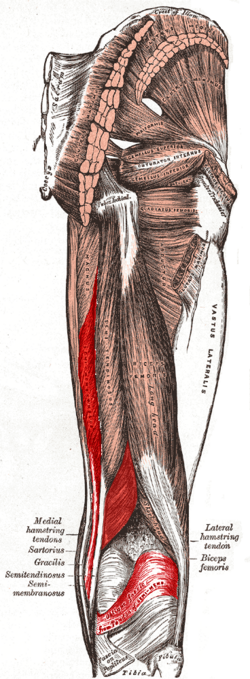Semimembranosus muscle
| Semimembranosus muscle | |
|---|---|

Muscles of the gluteal and posterior femoral regions (semimembranosus labeled at bottom left)
|
|
| Details | |
| Origin | Ischial tuberosity |
| Insertion | Medial condyle of tibia |
| Artery | Profunda femoris and |
| Nerve |
Tibial part of sciatic nerve (L5, S1 and S2) |
| Actions | Extension of hip and flexion of knee |
| Antagonist | Quadriceps muscle and Tensor fasciae latae |
| Identifiers | |
| Latin | Musculus semimembranosus |
| Dorlands /Elsevier |
m_22/12550673 |
| TA | A04.7.02.036 |
| FMA | 22438 |
|
Anatomical terms of muscle
[]
|
|
The semimembranosus (/ˌsɛmimɛmbrəˈnoʊsəs/) is medial most of the three hamstring muscles. It is so named because it has a flat tendon of origin. It lies posteromedially in the thigh, deep to the semitendinosus.
The semimembranosus, so called from its membranous tendon of origin, is situated at the back and medial side of the thigh.
Its origin is the superolateral aspect of the ischial tuberosity and it inserts on the medial condyle and nearby margin of tibia; intercondylar fossa of femur and lateral condyle of femur; and the ligament of the popliteal region (at the back of the knee). It arises by a thick tendon from the upper and outer impression on the ischial tuberosity, above and medial to the biceps femoris and semitendinosus.
The tendon of origin expands into an aponeurosis, which covers the upper part of the anterior surface of the muscle; from this aponeurosis, muscular fibers arise, and converge to another aponeurosis which covers the lower part of the posterior surface of the muscle and contracts into the tendon of insertion.
It is inserted mainly into the horizontal groove on the posterior medial aspect of the medial condyle of the tibia.
The semimembranosus is wider, flatter, and deeper than the semitendinosus (with which it shares very close insertion and attachment points).
...
Wikipedia
